 |
|
 |
 |
| |
 |
Jhongyun Fishing Port |
 |
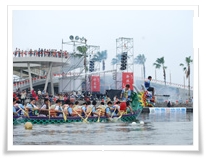 The Jhongyun Fishing Port has over 60 years of history and focuses on the development of deep-sea fishing; it occupies a crucial position in the development of Linyuan’s fishery. The port can accommodate 350 fishing boats (20 ton), usually the fishing boats operate in coaster waters, however sometimes they also travel as far as Penghu or Keelung to fish. Mainly migratory fishes are caught, however, overfishing by the Chinese fishing boats has caused a dramatic decline in the catch of Taiwanese fishing boats. The Jhongyun Fishing Port has over 60 years of history and focuses on the development of deep-sea fishing; it occupies a crucial position in the development of Linyuan’s fishery. The port can accommodate 350 fishing boats (20 ton), usually the fishing boats operate in coaster waters, however sometimes they also travel as far as Penghu or Keelung to fish. Mainly migratory fishes are caught, however, overfishing by the Chinese fishing boats has caused a dramatic decline in the catch of Taiwanese fishing boats. |
 |
 |
San Jiao Hu Zai Boat |
 |
 The majority of the fishing boats in Jhongyun Fishing Port utilize the stick-held dip net (called “San Jiao Hu Zai” Boat by the locals) and few trawlers. They usually head out to sea in the afternoon and return to port early next morning. San Jiao Hu is a stick-held dip net that catches fish with the aid of light; it is different from trawlers, which have nets on either sides of the boat. The majority of the fishing boats in Jhongyun Fishing Port utilize the stick-held dip net (called “San Jiao Hu Zai” Boat by the locals) and few trawlers. They usually head out to sea in the afternoon and return to port early next morning. San Jiao Hu is a stick-held dip net that catches fish with the aid of light; it is different from trawlers, which have nets on either sides of the boat. |
 |
 |
Abundant Catch |
 |
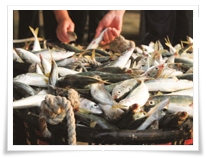 The catch in Linyuan is rich, from tuna to whitebait, there are also shrimp, Taiwan mauia shrimp, cutlass fish, tilapia, red sea-bream, bonito etc. There are different kinds of fish available throughout the seasons. The catch in Linyuan is rich, from tuna to whitebait, there are also shrimp, Taiwan mauia shrimp, cutlass fish, tilapia, red sea-bream, bonito etc. There are different kinds of fish available throughout the seasons.
Each morning, fish vendors can be seen waiting by the port for fishing boats to conduct business. The yells of the auctioneers in the fish market makes it a place bustling with activities! Some vendors even sell the freshly caught seafood at the Jhongyun Bridge nearby. |
 |
 |
Fishing Port Park |
 |
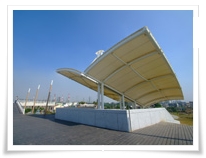 The park covers a surface area of 2.3 hectares; it used to be low-lying land and fish farms. Since it is close to the fishing port, thus it is named the Fishing Port Park. The park is a popular recreational venue for local citizens, it can oversee the Little Liouciou in the distant ocean from the Gaobing River, or one can admire the night scenery of the fishing port. The park covers a surface area of 2.3 hectares; it used to be low-lying land and fish farms. Since it is close to the fishing port, thus it is named the Fishing Port Park. The park is a popular recreational venue for local citizens, it can oversee the Little Liouciou in the distant ocean from the Gaobing River, or one can admire the night scenery of the fishing port.
The architectural contours of the park is closely related to the local marine ecology; the fluidity if the arcs and lights can be seen everywhere, just like a round dance. |
 |
 |
Fongyun Temple (Mazu Temple) |
 |
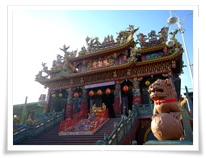 The temple worships the Goddess Lin Mo-niang from the Meijhou Island of Putian County in Fujian Province (Mazu) The temple worships the Goddess Lin Mo-niang from the Meijhou Island of Putian County in Fujian Province (Mazu)
The story dates back to over a century, where a boat from Nanao was sunk by the wind and the waves, one of the passengers onboard came ashore safely with the protection from the Goddess; in order to express his gratitude, he built a cottage where Mazu is worshipped.
Mazu is the guardian Goddess for sailors, and people have worshiped her for thousands of years. |
 |
 |
Jhongyun Beach |
 |
 Jhongyun beach is located in front of the Fongyun Temple, at the jetty, one can see fishing boats that have passed security checks head out to sea; sometimes several dozen travel together, making it an impressive sight. Jhongyun beach is located in front of the Fongyun Temple, at the jetty, one can see fishing boats that have passed security checks head out to sea; sometimes several dozen travel together, making it an impressive sight.
Behind the beach there is a magnificent viewing platform, which provides an ideal venue for people to enjoy their leisurely afternoon time. Here one can see senior citizens sitting and chatting, or taking their grandchildren for a walk; the most common sight is people power-walking on the beach.
Whether from the jetty or the viewing platform, beautiful scenery such as the sunset and the large ships can be appreciated by visitors.
|
 |
 |
Planetarium at Jhongyun Elementary School |
 |
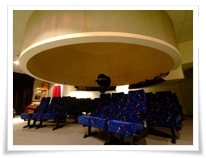 Jhongyun Elementary School is an old school, it is well known for its planetarium. Jhongyun Elementary School is an old school, it is well known for its planetarium.
It has been committed to the development of astronomical sciences and education for over two decades; in the past, national astronomy camps were organized during winter vacations, also regular astronomy news reports were published and handed out to students and teachers of the astronomy camp or from within the county free of charge to share astronomical knowledge. |
 |
 |
Dachen Lising Community |
 |
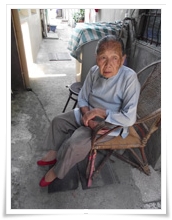 When the people of Dachen retreated to Taiwan, they were scattered throughout Taiwan, the Lising Community in Linyuan is one of their settlements. When the people of Dachen retreated to Taiwan, they were scattered throughout Taiwan, the Lising Community in Linyuan is one of their settlements.
In the alley, one can occasionally still see old ladies with bound feet (three-inch feet) sitting by the porch; there is also a type of fish noodle that no one has heard of, it is the traditional cuisine of the people of Dachen. |
 |
 |
Nearby Scenic Spots Recommended |
 |
|
Gangbu Old Residence, Huang Family Jiangjia Old Residence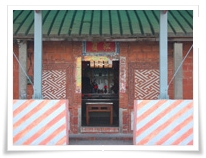
The ancestor of the Huang Family in Jiangjia, Huang Guang-jhen was from Nanjing County, Jhang Jhou Fu in Fujian Province who came to Taiwan over 300 years ago. His fifth generation grandson Huang Siao was a successful businessman and became a wealthy landlord in Gangbu. He constructed a large residence on the land near the port, which has gradually formed into an architectural cluster through 160 years of development. The existing old residence was declared as an important historic building by the County Government in 2003. |
 |
 |
Gangbu Old Residence, Anji Inn |
 |
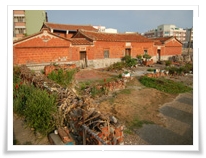 Anji Inn was built by Huang Syun-ren, the seventh generation descendant of Jiangsiapai over a century ago. He was a scholar from the end of the Cing Dynasty, who went into trading and constructed the property at Dingcuo Bay. At the time, he designed it with the dual purpose of business and residence. There are one building in the front and two at the rear; the architecture is exquisite. From the house, one may look into the distance at the entering and exiting rafts, and merchant boats could sail into the bay and offload cargo in front of the inn. At the time, brown sugar and rice were exported to Japan and coastal regions of China, it was the earliest international port in the township. Anji Inn was built by Huang Syun-ren, the seventh generation descendant of Jiangsiapai over a century ago. He was a scholar from the end of the Cing Dynasty, who went into trading and constructed the property at Dingcuo Bay. At the time, he designed it with the dual purpose of business and residence. There are one building in the front and two at the rear; the architecture is exquisite. From the house, one may look into the distance at the entering and exiting rafts, and merchant boats could sail into the bay and offload cargo in front of the inn. At the time, brown sugar and rice were exported to Japan and coastal regions of China, it was the earliest international port in the township. |
|
 |
|
|